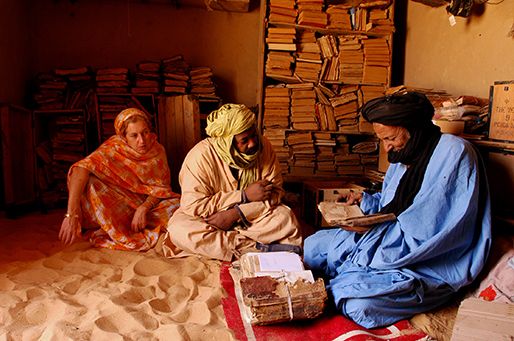SHELVES LAID BARE
When Al Qaeda-affiliated extremists captured Timbuktu last year, the world feared the worst for the storied city’s priceless trove of medieval Islamic manuscripts. And after French troops recaptured the city earlier this year, it appeared that the militants had made good on their threat to destroy one of history’s most important archives.
In March, Pulitzer Center grantee Yochi Dreazen visited the library where the manuscripts had been stored and, indeed, the shelves were bare: “The only traces of the ancient documents were a pile of mottled gray-and-black ashes, a few empty leather cases, and a single book-sized manuscript lying loose on the floor,” writes Yochi. But Yochi dug deeper—and uncovered the remarkable tale of how one dedicated resident of Timbuktu managed to organize a small army of local smugglers to rescue almost all of the collection. Yochi’s story, in The New Republic, reconstructs the narrow escape of Timbuktu’s most precious treasure.
THE LABOR OF CHILDREN
“On the rocky ground outside the Kollo mining village near the border between Burkina Faso and Ghana, about 100 people are working,” writes Pulitzer Center grantee Larry Price in a story for the Philadelphia Inquirer that accompanies his powerful and deeply disturbing photo essay. “They smash boulders into pebbles and pebbles into grit with primitive hammers and sticks. They haul buckets of well water up the hillside and, pouring this water into shallow pans filled with rock and dirt, they swirl the muddy mix, looking in the silt for tiny flecks of gold.”
What is so disturbing is the large percentage of workers who are small children. According to the U.N.’s International Labor Organization, as many as a million children between ages 5 and 17 work in the small-scale gold mines of Africa for wages that border on slavery. Child labor is against the law in Burkina Faso, but as Larry reports, the mines have evolved from a subsistence endeavor into the nation's third largest export. Those who profit are too often willing to look the other way on this abusive practice.
CONFLICT-FREE TIN
Consumers and corporations have long struggled to come to terms with the so-called conflict minerals of the Democratic Republic of Congo. We know these raw materials are key components in many of the electronic consumer products we use everyday, but we also understand that they are the source of continuing violence and instability in resource-rich countries like the DRC.
In a new documentary broadcast this week on Al Jazeera’s People & Power, filmmaker and Pulitzer Center grantee Fiona Lloyd-Davies looks at one tin mine in DRC’s South Kivu province where a new pilot project aims to create transparency throughout the mining and manufacturing process. Will it succeed? Fiona says the project is still in its infancy, but has strong local and corporate support.
